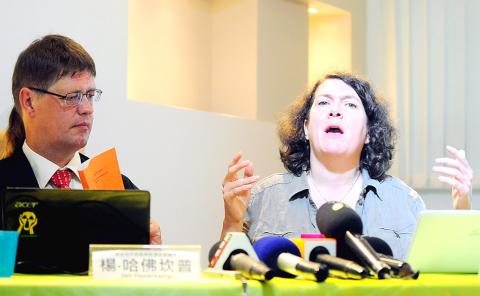Two nuclear specialists from Europe yesterday recommended terminating the Fourth Nuclear Power Plant project, saying it presents many risks and would not have obtained construction and operating permits if it had been evaluated according to the EU’s nuclear safety standards.
The two experts were invited by Greenpeace Taiwan and co-authored a critical review of the stress-test reports on the power plant in Gongliao District (貢寮), New Taipei City (新北市), conducted by Taiwan Power Co (Taipower) and an independent peer review team from the Organisation for Economic Co-operation and Development’s (OECD) Nuclear Energy Agency in March, as well as the national action plans by the Atomic Energy Council.
“We recommend terminating the Fourth Nuclear Power Plant project,” Oda Becker, one of the authors of the review, said at the the press conference in Taipei.

Photo: Wang Yi-sung, Taipei Times
Becker is a physicist from Germany who has been working in the field of nuclear safety for many years as an independent scientific consultant for clients including the Austrian government and several non-governmental organizations.
Given existing natural hazards, the design weaknesses and the deficiencies of the structure, system and components of the plant, as well as its short distance to New Taipei City, a severe accident would have disastrous consequences for millions of people, Becker said.
“It is impossible to reduce the risks to an acceptable safety level,” she said.
Becker said that Taipower’s assessment of the plant’s safety risks in the event of a disaster caused by earthquakes, floods or tsunamis were all underestimated, because the operator had either used insufficient or outdated for reference and therefore cannot accurately estimate the possible severe damage to the plant. Neither did it provide sufficient preventive measures to protect the plant against the most severe natural disasters.
Although Taipower and the government have often said they would immediately take “ultimate emergency measures” to abandon the plant to prevent a meltdown of the nuclear core, Becker questioned whether that would be effective in a worst-case scenario.
Since the proposed measures are activated by manpower and fuel damage can occur as fast as 1.6 hours after it is exposed above cooling-water level, it is questionable whether Taipower can activate the measures within such a short period of time, considering that it will be very difficult and dangerous to perform these measures after a big earthquake or tsunami.
Jan Haverkamp, a consultant on nuclear energy and energy policy for Greenpeace for many years, said that compared with the newer Advanced Boiling Water Reactors (ABWR) used in the EU, the outdated ABWR design of the Fourth Nuclear Power Plant has unaddressed issues, including whether it has protection against the impact of a large aircraft, a passive isolation condenser system, a core catcher, a passive containment cooling system and a dedicated power supply for severe accident management.
Commenting on the Atomic Energy Council’s plan to have the European Nuclear Safety Regulators Group (ENSREG) perform a stress-test on the Fourth Nuclear Power Plant in November, Haverkamp said that the ENSREG stress-test has a limited scope and can only assess some aspects of the plant’s safety problems, so the government and the public should not think that the plant would be completely safe if it passes the stress-test.

An essay competition jointly organized by a local writing society and a publisher affiliated with the Chinese Communist Party (CCP) might have contravened the Act Governing Relations Between the People of the Taiwan Area and the Mainland Area (臺灣地區與大陸地區人民關係條例), the Mainland Affairs Council (MAC) said on Thursday. “In this case, the partner organization is clearly an agency under the CCP’s Fujian Provincial Committee,” MAC Deputy Minister and spokesperson Liang Wen-chieh (梁文傑) said at a news briefing in Taipei. “It also involves bringing Taiwanese students to China with all-expenses-paid arrangements to attend award ceremonies and camps,” Liang said. Those two “characteristics” are typically sufficient

A magnitude 5.9 earthquake that struck about 33km off the coast of Hualien City was the "main shock" in a series of quakes in the area, with aftershocks expected over the next three days, the Central Weather Administration (CWA) said yesterday. Prior to the magnitude 5.9 quake shaking most of Taiwan at 6:53pm yesterday, six other earthquakes stronger than a magnitude of 4, starting with a magnitude 5.5 quake at 6:09pm, occurred in the area. CWA Seismological Center Director Wu Chien-fu (吳健富) confirmed that the quakes were all part of the same series and that the magnitude 5.5 temblor was

The brilliant blue waters, thick foliage and bucolic atmosphere on this seemingly idyllic archipelago deep in the Pacific Ocean belie the key role it now plays in a titanic geopolitical struggle. Palau is again on the front line as China, and the US and its allies prepare their forces in an intensifying contest for control over the Asia-Pacific region. The democratic nation of just 17,000 people hosts US-controlled airstrips and soon-to-be-completed radar installations that the US military describes as “critical” to monitoring vast swathes of water and airspace. It is also a key piece of the second island chain, a string of

The Central Weather Administration has issued a heat alert for southeastern Taiwan, warning of temperatures as high as 36°C today, while alerting some coastal areas of strong winds later in the day. Kaohsiung’s Neimen District (內門) and Pingtung County’s Neipu Township (內埔) are under an orange heat alert, which warns of temperatures as high as 36°C for three consecutive days, the CWA said, citing southwest winds. The heat would also extend to Tainan’s Nansi (楠西) and Yujing (玉井) districts, as well as Pingtung’s Gaoshu (高樹), Yanpu (鹽埔) and Majia (瑪家) townships, it said, forecasting highs of up to 36°C in those areas